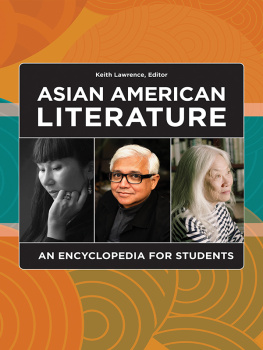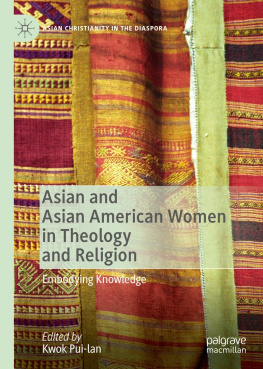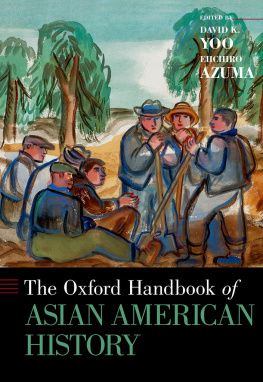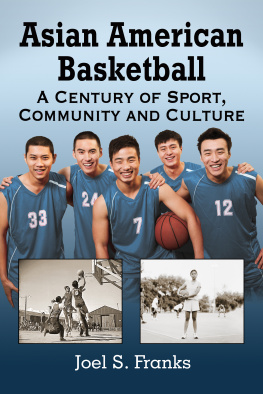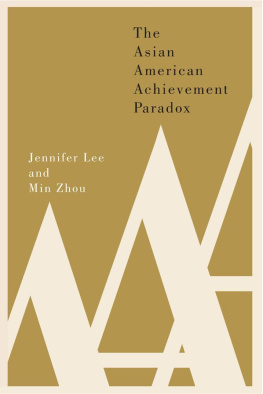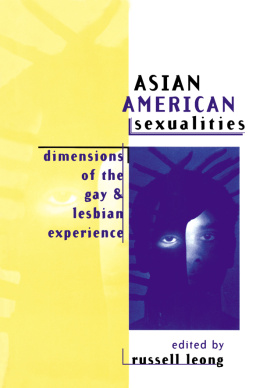Asian American Literature
Asian American Literature
An Encyclopedia for Students
Keith Lawrence, Editor

Copyright 2021 by ABC-CLIO, LLC
All rights reserved. No part of this publication may be reproduced, stored in a retrieval system, or transmitted, in any form or by any means, electronic, mechanical, photocopying, recording, or otherwise, except for the inclusion of brief quotations in a review, without prior permission in writing from the publisher.
Library of Congress Cataloging-in-Publication Data
Names: Lawrence, Keith, 1954- editor.
Title: Asian American literature : an encyclopedia for students / Keith Lawrence, editor.
Other titles: Asian American literature (ABC-CLIO, LLC)
Description: Santa Barbara, California : Greenwood, an imprint of ABC-CLIO, LLC, 2021. | Includes bibliographical references and index.
Identifiers: LCCN 2020053554 (print) | LCCN 2020053555 (ebook) | ISBN 9781440872884 (hardcover) | ISBN 9781440872891 (ebook)
Subjects: LCSH: American literatureAsian American authorsEncyclopedias. | American literatureAsian American authorsBio-bibliographyDictionaries. | Asian AmericansIntellectual lifeEncyclopedias. | Asian Americans in literatureEncyclopedias.
Classification: LCC PS153.A84 A73 2021 (print) | LCC PS153.A84 (ebook) | DDC 810.9/895 [B]dc23
LC record available at https://lccn.loc.gov/2020053554
LC ebook record available at https://lccn.loc.gov/2020053555
ISBN: 978-1-4408-7288-4 (print)
978-1-4408-7289-1 (ebook)
252423222112345
This book is also available as an eBook.
Greenwood
An Imprint of ABC-CLIO, LLC
ABC-CLIO, LLC
147 Castilian Drive
Santa Barbara, California 93117
www.abc-clio.com
This book is printed on acid-free paper 
Manufactured in the United States of America
Contents
This is a short preface. I make only four points.
First,Asian American Literature: An Encyclopedia for Students was from the beginning designed to accommodate only two entry types: introductory entries outlining or explaining broad elements of Asian North American literature and author entries detailing important biographical elements and textual contributions of each respective author.
You wont find entries about individual novels, poems, or other texts in this volume. Information about any given text is included within the relevant author entry. The index at the end of this volume will help you locate the information you need.
Second, even given the limited focus of this volume as just explained, it is not complete. Perhaps no such volume is. Inevitably, at least some of our readers may search in vain for a writer they enjoy or one theyve been assigned to read about.
As Kim Kennedy-White and I initially planned the volume, we tried, with the help of authorities in the field and our contributors themselves, to select Asian North American writers who are most frequently assigned in relevant high school and university classroomsor, despite current academic neglect, who are most deserving of rediscovery and appreciation.
These are, admittedly, fraught and unstable principles on which to build an academic volume, and they may even appear to constitute canon-building in disguise. Our intention was never to do such workbut simply to create a volume that would be fair and balanced and that, above all, would be useful to its intended audience.
Third, despite its title, the focus of this volume is Asian North American literature. Its entries are about writers of Asian descent who make (or who have made) Canada or the United States (or both) their home. Introductory entries focus on Asian American and Asian Canadian literature, history, and culture.
Fourth, we who have contributed to or edited the volume have tried to address you, our student readers. We respect you, and we respect your time. We have deliberately kept our entries brief. Entries for especially productive or influential authors may be longer, but all are succinct, focused, and clear.
The introductory entries may be read as historical surveys or overviews of the subjects they address. As a rule, each is written in chronological order, showing how the subjector North Americans understanding of ithas changed over time.
Author entries follow an established format. The opening paragraph specifies the authors ethnicity and makes summary statements about her or his influence or significance. Subsequent paragraphs cover the authors birth and biography. Paragraphs focused on best-known or influential texts follow. Most entries conclude with a summary of awards or honors given the author in question; the final paragraph may explain where the writer currently lives or works (if living) or where and how she or he died (if deceased)and may provide summative statements regarding the writers reputation or legacy.
Each author entry is followed by the name of the contributor in italics (you may look up the names in the About the Editor and Contributors chapter for brief biographical information) and by a list of Selected Works written by the author (works mentioned in the entry will appear in this list, together with other works that readers might find interesting). Each introductory entry and author entry concludes with a Suggested Further Reading section listing all works cited within the respective entry and showing additional useful texts, print and online, that readers may consult for additional information.
As you refer to this volume over time, its use should become increasingly intuitive to you.
Keith Lawrence
Provo, Utah
October 2020
As Asian American Literature: An Encyclopedia for Students has moved from concept to completion, many wonderful people have made invaluable contributions to its unfolding.
First, I acknowledge Kim Kennedy-White, former senior acquisitions editor at ABC-CLIO. She initiated this volume, and her thoughtful shepherding of the early stages of the project, together with her always positive encouragement and support, will be remembered with fondness and gratitude. Similarly, I acknowledge the editorial expertise and kind support of Catherine M. Lafuente, acquisitions editor at ABC-CLIO, who helped transition the project toward final manuscript preparation, and Kousalya Devi Krishnamoorthy, editorial project manager at Amnet Systems, who very efficiently steered the project to its completion.
I also express sincere thanks to Kevin Downing, editorial director at ABC-CLIO, who coordinated the final months of this project and enabled it to move smoothly forward. I deeply appreciate his patient assistance and understanding.
Perhaps above all, thanks is due to the wonderful contributors to this volume. Without them it would not exist, obviously. More than that, however, their expertise, graceful writing, and thoughtful research have produced entries that will speak to studentsthat will motivate enduring respect and love for North Americas amazing Asian American writers.
Funding from ABC-CLIO was vital to the success of this project, especially during its first months. And a generous grant from the Canadian Studies office at Brigham Young University made it possible to finish the project in a timely, professional way. A special thanks to Kevin Shafer and Ryan Zirkerand to alumni and other donors to BYUs Canadian Studies program.

